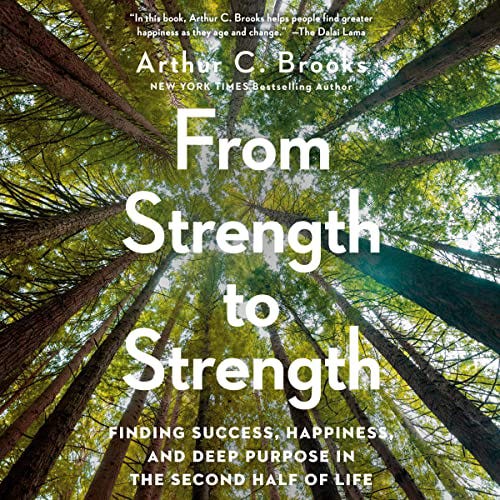Book 3: From Strength to Strength by Arthur C. Brooks
The Life-Changing Blueprint for Finding Happiness and Purpose in Your Next Chapter
As I mentioned on X, I recently took a left turn from the 50 Book Challenge and wound up reading a book NOT on my list. Get ready for a book that will challenge you to rethink the way you see you!
You can blame or credit my wife, Heather for this one. 🙂 The title is From Strength to Strength by Arthur C. Brooks. It’s an enlightening message for the high achiever facing a frustrating decline in creativity and innovation at work.
As always, you’ll greatly benefit from reading the books I recommend, but I read them so you don’t have to.
What you get in the second wave of your career is more valuable than in the first.
Brooks breaks down a person’s career into two primary phases:
The creative, innovative phase
The mature, wisdom phase
It’s worth noting that some careers have a 6 year window for the first phase. Some have 20 years. But all high achievers share a common frustration: when the creative, award winning innovation phase is over, it’s really over.
We can save ourselves years of heartache once we recognize that statistically we only have a limited number of years from the start of a career to innovate, create, and dazzle the market. The limits sound rather concrete.
Tenured researchers maintain positions they can no longer deserve because they’ve unknowingly reached a second phase of career which is not conducive to the same approach we take when we are young.
We’ll call this the wisdom phase. This is the phase of one’s life in which it would be ideal to pivot into more of a teaching, mentoring, curating role for others. The accumulation of wisdom over the prior years provides the raw data which your now older and wiser self can weave into a cohesive tale that instructs, inspires, and warns.
The secret to success in this second wave is to recognize first that you’ve entered it (self-awareness), and then to seek a more fitting role given the understandings we take away from the remaining chapters of this book.
How to Make the Transition
The first section of the book is the most interesting to me, because it defines a situation. I didn’t know existed outside of personal experience. It’s reassuring to know this is more of a observable fact among professionals everywhere.
As he launches into a multi-chapter tutorial, the author takes a left turn that some of my fellow readers will find difficult to follow. He references the Buddha and the eight laws as a tool for exercising and adjusting ones mindset.
It is here I will provide you a lengthy quote so you can read it in his own words.
“I have learned through my worldly success to search for satisfaction in the world‘s rewards which are ultimately not satisfying. I will suffer with dissatisfaction if I attain these rewards if I’m attached to them and suffer even more when I no longer earn them them.
The only solution to this problem is to shed my attachments and redefine my desires. To do so is my path to enlightenment, and my second curve.
Neither Thomas nor the Buddha argued that there is something inherently evil about worldly rewards. In fact, they can be used for great good. Money is critical for a functioning society and. supporting your family. Power can be wielded to lift others up. Pleasure leaven’s life. And fame can attract attention to the sources of moral elevation. But as attachments, the focus of our life‘s attention, and as ends instead of means the problem is simple: They cannot bring the deep satisfaction we desire.
We chase our worldly attachments up our first success curve. We work ourselves to death to gain the elusive satisfaction. When the success curve starts to bend back down, the attachments give us tremendous suffering. These attachments must be chipped away. To make it possible to jump onto the second curve.”
Put in my own words, we start this life, seeking trophies and money, and fancy things because we believe that possessing them will usher in this great and satisfying life of luxury. Whether it’s the desire to silence, the fear of financial security, or to accumulate enough valuable things to demonstrate our own value, we mark our success we set our goals based on these accomplishments.
This lines up with everything I’ve heard and read from celebrities and millionaires who acknowledge that the greatest depression they reached was at the height of their fame and wealth, because that was the precisely the moment in which they realize that there goals couldn’t make them happy.
And so, logic dictates that if we are going to transition from a high achiever/creative/innovative career to something humbler, will have to redefine our measurements of success.
A teacher rarely ever ear celebrity or fame or significant wealth. But they can experience the deep and satisfying reward of having enrich the lives of others who might learn from our victories and our mistakes.
Bottom line: It’s not over for you because you’re no longer the alpha innovator. What you’ve learned along the way is priceless and useful for the next generation. It’s up to you to find a way to use it to give them a higher, stronger foundation.
P.S. If the chapter titled “Ponder Your Death” feels a little uncomfortable, it’s supposed to.



